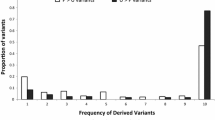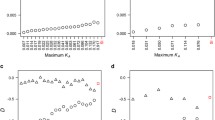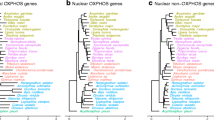Summary
The esterase 5 (Est-5 = gene, EST 5 = protein) enzyme in Drosophila pseudoobscura is encoded by one of three paralogous genes, Est-5A, Est5B, and Est-5C, that are tightly clustered on the right arm of the X chromosome. The homologous Est-6 locus in Drosophila melanogaster has only one paralogous neighbor, Est-P. Comparisons of coding and flanking DNA sequences among the three D. pseudoobscura and two D. melanogaster genes suggest that two paralogous genes were present before the divergence of D. pseudoobscura from D. melanogaster and that, later, a second duplication occurred in D. pseudoobscura. Nucleotide sequences of the coding regions of the three D. pseudoobscura genes showed 78–85% similarity in pairwise comparisons, whereas the relatedness between Est-6 and Est-P was only 67%. The higher degree of conservation in D. pseudoobscura likely results from the comparatively recent divergence of Est-5B and Est-5C and from possible gene conversion events between Est-5A and Est-5B. Analyses of silent and replacement site differences in the two exons of the paralogous and orthologous genes in each species indicate that common selective forces are acting on all five loci. Further evidence for common purifying selective constraints comes from the conservation of hydropathy profiles and proposed catalytic residues. However, different levels of amino acid substitution between the paralogous genes in D. melanogaster relative to those in D. pseudoobscura suggest that interspecific differences in selection also exist.
Similar content being viewed by others
References
Beverley SM, Wilson AC (1984) Molecular evolution in Drosophila and the higher Diptera II. A time scale for molecular evolution. J Mol Evol 21:1–13
Brady JP, Richmond RC, Oakeshott JG (1990) Cloning of the esterase-5 locus from Drosophila pseudoobscura and comparison with its homologue in D. melanogaster. Mol Biol Evol 7:525–546
Brown AJL, Ish-Horowicz D (1981) Evolution of the 87A and 87C heat-shock loci in Drosophila. Nature 290:677–682
Collet C, Nielsen KM, Russell RJ, Karl M, Oakeshott JG, Richmond RC (1990) Molecular analysis of duplicated esterase genes in Drosophila melanogaster. Mol Biol Evol 7:9–28
Cooke PH, Oakeshott JG (1989) Amino acid polymorphisms for esterase-6 in Drosophila melanogaster. Proc Natl Acad Sci USA 86:1426–1430
Devereux J, Haeberli P, Smithies O (1984) A comprehensive set of sequence analysis programs for the VAX. Nucleic Acids Res 12:387–395
Eickbush TH, Burke WD (1986) The silkmoth late chorion locus II. Gradients of gene conversion in two paired multigene families. J Mol Biol 190:357–366
Fischer JA, Maniatis T (1985) Structure and transcription of the Drosophila mulleri alcohol dehydrogenase genes. Nucleic Acids Res 13:6899–6917
Flanagan JG, Lefranc M, Rabbitts TH (1984) Mechanisms of divergence and convergence of the human immunoglobulin alpha1 and alpha2 constant region gene sequences. Cell 36: 681–688
Gilbert W (1985) Genes-in-pieces revisited. Science 228:823–824
Hubby JL, Lewontin RC (1966) A molecular approach to the study of genic heterozygosity in natural populations. I. The number of alleles at different loci in Drosophila pseudoobscura. Genetics 54:577–594
Kaiser CA, Preuss D, Grisafi P, Botstein D (1987) Many random sequences functionally replace the secretion signal sequence of yeast invertase. Science 235:312–317
Keller EB, Noon WA (1985) Intron splicing: a conserved internal signal in introns of Drosophila pre-mRNAs. Nucleic Acids Res 13:4971–4981
Kimura M, Ohta T (1974) On some principles governing molecular evolution. Proc Natl Acad Sci USA 71:2848–2852
Kyte J, Doolittle RF (1982) A simple method for displaying the hydropathic character of a protein. J Mol Biol 157:105–132
Maizel JV, Lenk RP (1981) Enhanced graphic matrix analysis of nucleic acid and protein sequences. Proc Natl Acad Sci USA 78:7665–7669
Mane SD, Tepper CS, Richmond RC (1983) Studies of esterase-6 in Drosophila melanogaster. XIII. Purification and characterization of the two major isozymes. Biochem Genet 21: 1019–1039
Myers M, Richmond RC, Oakeshott JG (1988) On the origins of esterases. Mol Biol Evol 5:113–119
Needleman SB, Wunsch CD (1970) A general method applicable to the search for similarities in amino acid sequences of two proteins. J Mol Biol 48:443–453
Nei M (1987) Molecular evolutionary genetics. Columbia University Press, New York
Oakeshott JG, Collet C, Phillis RW, Nielsen KM, Russell RJ, Chambers GK, Ross V, Richmond RC (1987) Molecular cloning and characterization of esterase-6, a serine hydrolase of Drosophila. Proc Natl Acad Sci USA 84:3359–3363
Ohno S (1970) Evolution by gene duplication. Springer-Verlag, New York
Perler F, Efstradiatis A, Lomedico P, Gilbert W, Kolodner R, Dodgson J (1980) The evolution of genes: the chicken pre-proinsulin gene. Cell 20:555–566
Slightom JL, Blechl AE, Smithies O (1980) Human fetal G gamma- and A gamma-globin genes: complete nucleotide sequences suggest that DNA can be exchanged between these duplicated genes. Cell 21:627–638
Sokal RR, Rohlf FJ (1969) Biometry. WH Freeman, San Francisco, pp 607–610
Taylor WR (1986) The classification of amino acid conservation. J Theor Biol 119:205–218
Throckmorton LH (1975) The phylogeny, ecology, and geography of Drosophila. In: King RC (ed) Handbook of genetics, vol 3. Plenum, New York, pp 421–469
von Heijne G (1984) How signal sequences maintain cleavage specificity. J Mol Biol 173:243–251
Weiss EH, Mellor A, Golden L, Fahrner K, Simpson E, Hurst J, Flavell RA (1983) The structure of a mutant H-2 gene suggests that the generation of polymorphism in H-2 genes may occur by gene conversion-like events. Nature 301:671–674
Zouros E, van Delden W, Odense R, van Dijk H (1982) An esterase duplication in Drosophila: differences in expression of duplicate loci within and among related species. Biochem Genet 20:929–942
Author information
Authors and Affiliations
Additional information
Offprint requests to: R.C. Richmond
Rights and permissions
About this article
Cite this article
Brady, J.P., Richmond, R.C. An evolutionary model for the duplication and divergence of esterase genes in Drosophila . J Mol Evol 34, 506–521 (1992). https://doi.org/10.1007/BF00160464
Received:
Accepted:
Issue Date:
DOI: https://doi.org/10.1007/BF00160464




